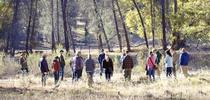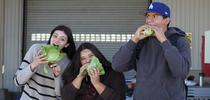UC Cooperative Extension | Agricultural Experiment Station
Foundation created to energize community support for UC ANR mission

Board of Directors to promote philanthropy through advocacy and fundraising in support of agriculture, natural resources and community health The new University of California Agriculture and Natural Resources Foundation has been established to...
UC Delivers
In the late 1980's and through most of the 1990's, California had about 15,000 acres in apples and ranked second only to Washington State. Due to strong market competition and low prices since that time, acreage has been on a steady decline--except in organic production.Many California growers wanted to take advantage of higher prices and brisk demand for organically produced apples. Unfortunately, they have had to contend with huge losses from diseases like apple scab and powdery mildew as well as insects such as codling moth and aphids. In years with wet spring rains, apple scab caused a complete loss of blossoms and fruit. In some years, worm-infested apples caused by codling moths resulted in as much as 90% damage in untreated orchards. Aphids and powdery mildew were secondary pests, but under certain conditions could decimate production in orchards where conventional pesticides were not used.
Read about: Organic Apple Industry in California | View Other Stories







